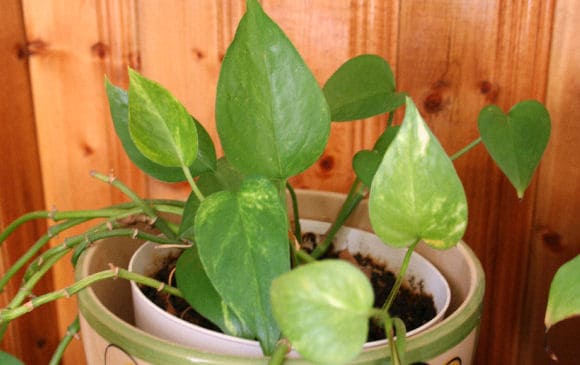These two plants are the best plants for low light areas that I know. If you love having house plants but your rooms face north, or you don’t get a lot of bright sunlight, try growing these two plants for low light areas.
What Is Low Light?
Plants need light to make their own food, a process known as photosynthesis. Depending on where a plant evolved, it may need bright, direct sunshine, or it may be fine with very dim, filtered light.
Think about a cactus plant evolving under desert conditions. In its natural habitat, cactus are bathed with blindingly hot sunshine every day for most of the year. They need bright, direct sunlight.
Low light house plants evolved in areas as under story plants. Many are jungle plants, living under the thick tree canopy near the forest floor. To these plants, filtered sunlight shining through tree leaves is plenty. Anything more can harm them.
As you walk around your home, which rooms are the brightest? Do some rooms face south? Does the room get bright light in the morning or towards sunset? Each of these questions can help you figure out the amount of light available to house plants on the window sill in your home.
Most homeowners struggle with light for plants. Supplemental light such as grow bulbs produce light in the red, green and blue spectrum that plants need to grow. While you can add plant lights in order to grow house plants, by choosing a plant that loves low light, you can avoid having to purchase grow lights and instead just enjoy a pretty house plant on its own merits.
Two Easy to Grow Low Light House Plants
These two house plants are both “low light” house plants and super easy to grow. If you have a black thumb and tend to kill everything you bring home from the nursery and garden center, you may still be successful with these plants.
 Licensed from(C) borojoint/DepositPhoto.com
Licensed from(C) borojoint/DepositPhoto.com
Spathiphyllum (“Peace Lily”)
Spathiphyllum is better-known by its common name, the Peace Lily. It has dark green, glossy, sword-shaped leaves. When the plant grows into its pot or container (a process called “becoming pot bound) it sends up flowers. Each flower starts as a tightly curled white spike which gradually unfurls into the flower. It does not have a scent, but the blooms last a long time.
Peace Lily thrives in very low light. I have mine in a northern corner of an out of the way room and it loves it. They need plenty of water, however, so be sure to water it frequently. If the leaves start drooping, your poor Peace Lily needs water. Feed every six weeks during the winter with a liquid fertilizer diluted in water according to the package directions. A simple 10-10-10 house plant fertilizer should be fine.
Pothos
Pothos goes by many names: Devil’s Ivy, can’t kill it plant, you name it. In its natural state, pothos grows as a jungle vine. Some varieties have dark green, heart-shaped leaves. Others have white or golden stripes or speckles on the leaves. The dark green leaf varieties can tolerate lower light than the speckled leaf varieties. If you do grow a speckled leaf variety in very low light, it may lose its variegated leaves and just turn to a solid dark green color.
Pothos grows like a weed, frankly. My own is in a very dark corner of a room that never gets bright light, and the plant has already outgrown two pots. It needs plenty of water, a light fertilizer every 6 weeks or so, and that’s about it.
You can easily take cuttings from your pothos plant. Just snip off one of the trailing vines near a joint and stick the clipped end in a vase or glass of water. When roots appear, plant it in house plant soil and keep it moist. Voila – instead new plant!
My own pothos has funny history to it. I was working in Manhattan and had just started a job at an office building near Penn Station. The building felt so sterile. Everything in that office was beige or gray. Beige walls, beige cubicles, gray carpet, beige computers…I thought I’d go mad from the lack of life there! I need plants, flowers, animals, greenery, something of nature or I feel cooped up and unhappy.
So I walked down to the florist and there on a shelf was a small display of tiny house plants. I saw the pothos and thought, “Ah, the perfect office plant!”
That pothos became the mascot for our department. People would stop by my desk just to see my little plant. It lived under fluorescent lights, and while I can’t say it was happy in the cubicle with me, it didn’t die, which is a plus!
Today, it’s about six times the size it was when I first saw it on the florist’s shelf. I’ve had the plant 10 years and it’s still growing strong. They really are tough as nails plants and pothos are quite easy to grow.
Poisonous to Pets
Both pothos and peace lily can be poisonous to dogs and cats. My own menagerie leaves both plants alone, but you should know that ingestion of peace lily can cause mouth and tongue irritation and vomiting. Pothos contains calcium oxalate, and ingestion can be fatal for small pets.








I’m terrible with plants but I might just have to try the Peace Lily this year…it’s such a gorgeous plant! Thanks for sharing at Welcome Home Wednesdays!
I have pothos in my house that are grown from some that my mother got thirty years ago. I’m amazed that they grow and survive that long. And they are so easy to create new plants from also. Really a great houseplant. Thanks so much for sharing at Inspiration Thursday!